|
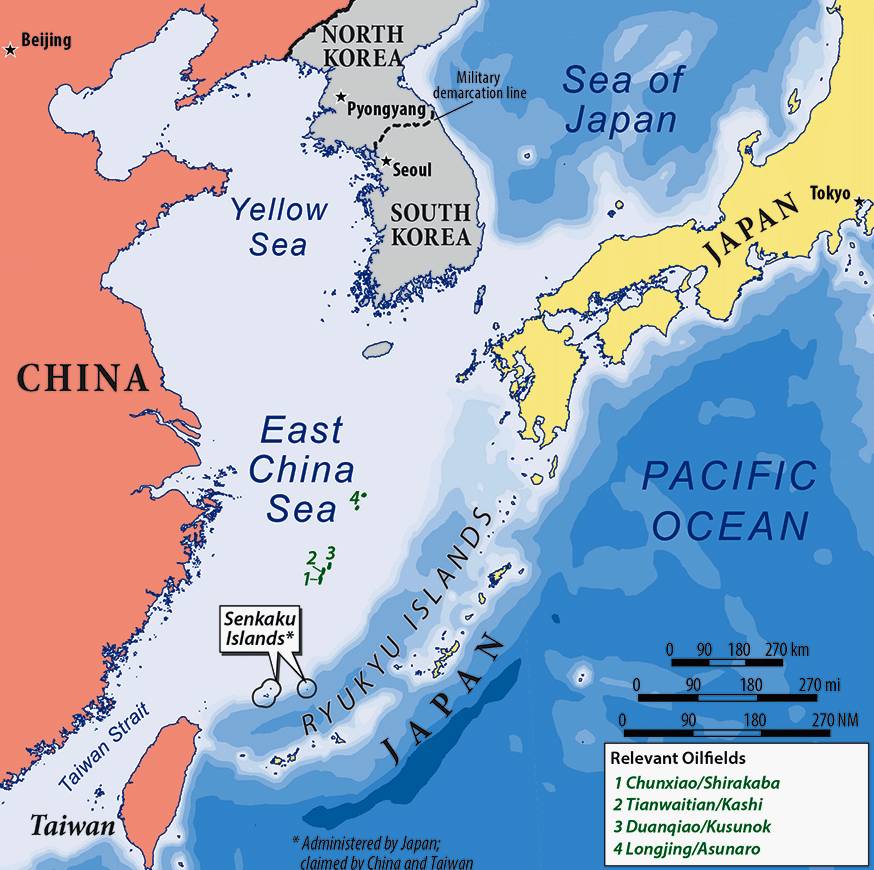
Map
of the East China Sea
The East China Sea is a marginal sea east of China. It is a part of the
Pacific Ocean and covers an area of roughly 1,249,000 square
kilometres (482,000 sq mi). The East China Sea is bounded on the east by Kyūshū and the Ryukyu Islands of
Japan, on the south by the South China Sea, and on the west by the Asian continent. It connects with the Sea of Japan through the Korea Strait; it opens in the north to the Yellow Sea.
States with borders on the sea (clockwise from north) include: South Korea, Japan, Republic of China (Taiwan) and the People's Republic of
China.
In oceanography, a marginal sea is a sea partially enclosed by islands, archipelagos, or peninsulas, adjacent to or widely open to the open ocean at the surface, and/or bounded by submarine ridges on the sea floor.
In addition to
local shipping traffic in and out of Chinese and Korean ports, the East China Sea serves as the main shipping route from the South China Sea to Japanese and other North Pacific ports. The main ports of the East China Sea are Shanghai in China,
Nagasaki in Japan, and Chi-lung in
Taiwan.
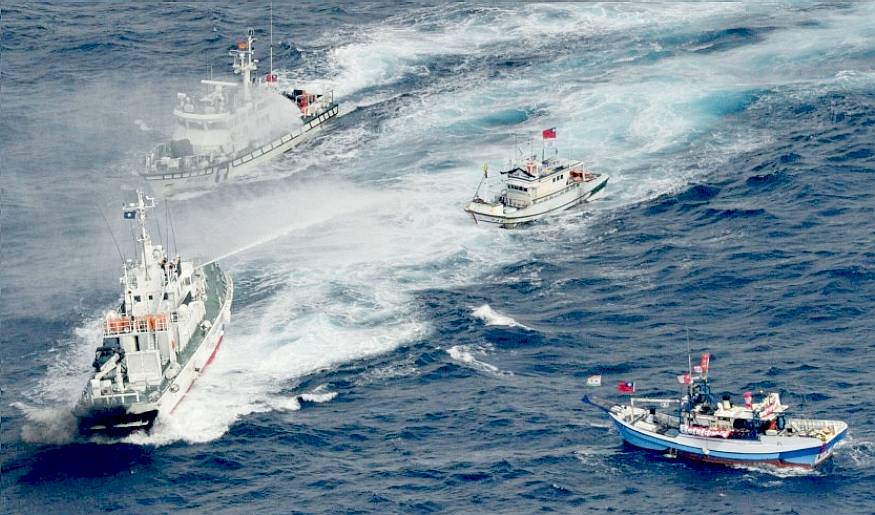
This
aerial view shows a Japanese Coast Guard patrol ship spraying water at fishing boats from Taiwan, as Taiwan's Coast Guard vessel sails near the disputed islands in the East China Sea.
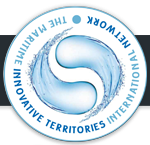
INNOVATION
& BLUE GROWTH
- Symposium, Qingdao, China, 28-30 October 2013 /
研讨会 “创新
& 蓝色发展”,
中国,青岛 2013年10月28-30日
The "Innovation and Blue Growth" symposium, which
was held in Qingdao in China from the 28th to the 30th of October 2013 was one of the first international actions of the Maritime Innovative Territories International Network, MiTiN.
Organized by Qingdao (China) and Brest (France) with the support and contributions of the MiTiN network, the symposium will bring together experts from the scientific, economic, private and public sectors. Through scientific advice and the analyses of technical, economic and regulatory conditions, stakes and perspectives will be highlighted for a better understanding of the ocean and a better valorization of its resources, especially the biological ones.
Two topics were discussed in two sessions: oceanography and marine bio-resources. Advances in oceanography research can give a better knowledge of the complexity of the physical, chemical and biological processes that govern the marine environment. Fundamental knowledge of the ocean will open the way to sustainable exploitation of marine bio-resources for food, energy or health-related challenges.
Combining socio-economic development and environmental protection is the objective of sustainable development policies. Nowadays, “Blue Growth” is an international challenge in the maritime world.
The exploitation of marine resources (energy, minerals and food) is essential to global development, but such practices impact the marine environment, and more generally the climatic and biological balance of the planet.
To find a balance between exploitation and preservation of the ocean is a very complex task. In July 2012, approximately twenty maritime regions involved in marine science and technology issues (Brest, Qingdao, San Diego, Kiel, Rimouski, Southampton, Porto…)
created the Maritime Innovative Territories International Network (MiTiN). By the signature of the "Convention for
Blue Growth", the MiTiN regions confirmed their support to a new and sustainable maritime economy.
TERRITORIAL DISPUTES
There are disputes between the People's Republic of China (PRC), Japan, and
South Korea over the extent of their respective exclusive economic zones (EEZ).
The dispute between the PRC and Japan concerns the different application of the 1982 United Nations Convention on the Law of Sea (UNCLOS), which both nations have ratified. China and Japan both claim 200 nautical miles EEZ rights, but the East China Sea width is only 360 nautical miles. China proposed the application of UNCLOS, considering the natural prolongation of its continental shelf, advocating that the EEZ extends as far as the Okinawa Trough. Its Ministry of Foreign Affairs has stated that "the natural prolongation of the continental shelf of China in the East China Sea extends to the Okinawa Trough and beyond 200 nautical miles from the baselines from which the breadth of the territorial sea of China is measured," which is applicable to the relevant UNCLOS provisions that support China's right to the natural shelf. In 2012, China presented a submission under the
UNCLOS concerning the outer limits of the continental shelf to the UN. However, Japan claims about 40,000 square kilometers part of this territory as its own EEZ because it is within 200 nautical miles (370 km) from its coast, and thus proposed the Median line division of the EEZ.
In 1995, the People's Republic of China (PRC) discovered an undersea natural gas field in the East China Sea, namely the Chunxiao gas field, which lies within the Chinese EEZ while Japan believes it is connected to other possible reserves beyond the median line. Japan has objected to PRC development of natural gas resources in the East China Sea near the area where the two countries Exclusive Economic Zone (EEZ) claims overlap. The specific development in dispute is the PRC's drilling in the Chunxiao gas field, which is located in undisputed areas on China's side, three or four miles (6 km) west of the median line proposed by Japan. Japan maintains that although the Chunxiao gas field rigs are on the PRC side of a median line that Tokyo regards as the two sides' sea boundary, they may tap into a field that stretches underground into the disputed area.
Japan therefore seeks a share in the natural gas resources. The gas fields in the Xihu Sag area in the East China Sea (Canxue, Baoyunting, Chunxiao, Duanqiao, Wuyunting, and Tianwaitian) are estimated to hold proven reserves of 364 BCF of natural gas. Commercial operations began 2006. In June 2008, both sides agreed to jointly develop the Chunxiao gas fields, but they have never been able to agree on how to execute the plan.
Rounds of disputes about island ownership in the East China Sea have triggered both official and civilian protests between China and Japan.
The dispute between PRC and South Korea concerns Socotra Rock, a submerged reef on which South Korea has constructed the Ieodo Ocean Research Station. While neither country claims the rock as territory, the PRC has objected to Korean activities there as a breach of its EEZ rights.
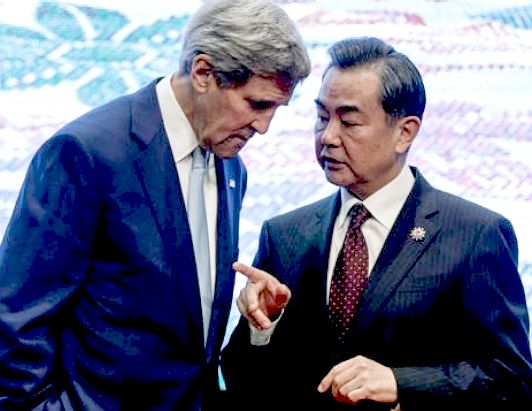
NOV 2012 BEIJING
Chinese patrol boats have harried the Japanese Coast Guard many times a week for more than a month in an unusually relentless response to their latest maritime spat.
Four Chinese craft typically push to within hailing distance of Japan's ships. They flash illuminated signs in Japanese to press Beijing's argument that it has ancient claims to a set of tiny East China Sea islands now controlled by Tokyo. China says its craft have tried to chase the Japanese away at least once, although Japan denies any of its ships fled.
With emotions running high, any accident or miscalculation in these maritime missions could yield unexpected outcomes.
"One side might deploy a naval vessel in a support fashion, a move that the other would match," said M. Taylor Fravel of the Massachusetts Institute of Technology, who is closely following the dispute.
Japan has made it clear that it intends to meet the Chinese challenge in kind.
Japanese Coast Guard spokesman Yasuhiko Oku said the dispute was a factor behind the government's allocation last week of 17 billion
yen ($212 million) to beef up the
Coast Guard fleet with seven new patrol ships and three
helicopters, though he said the new assets are not only for use around the islands.
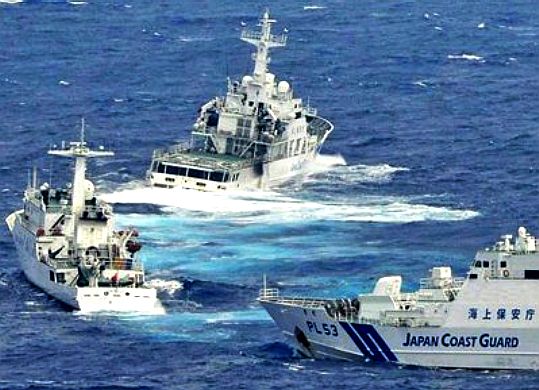
SEPT 2012
Taiwan has sent a fleet of boats into the East China Sea, adding to the tension surrounding a group of islands which have already sparked a diplomatic stand-off between China and Japan.
It is believed Taiwan sent around 100 fishing boats and coast guard ships into the disputed water, in protest at Japan's purchase of an uninhabited archipelago situated off the eastern coast of China.
Japan's purchase of the islands from a private owner has already been condemned in Beijing, which claims
China discovered the islands in the 14th century.
Taiwan also believes it has a claim, and has also been embroiled in a lengthy dispute with Japan over fishing rights in the disputed area.
The Taiwanese flotilla was chased away by Japanese coast guard, using water cannons. Following the incident, Japan's chief cabinet secretary Osamu Fujimura stressed the need for
peaceful resolution of the dispute.
"We've just lodged a protest with the Taiwan side. Our stance is that this is something that needs to be solved in the context of good bilateral ties between Japan and Taiwan. We would like to address the issue calmly," Fujimura said.
The Taiwanese entry comes a day after Chinese vessels visited the East China Sea for surveillance, the latest installment in the ongoing dispute between
Beijing and
Tokyo. The Chinese government says it will use the talks to press for an amicable resolution.
"China will urge Japan to correct their mistakes and make efforts in improving ties," said Chinese Foreign Ministry spokesperson Hong Kei ahead of the talks.
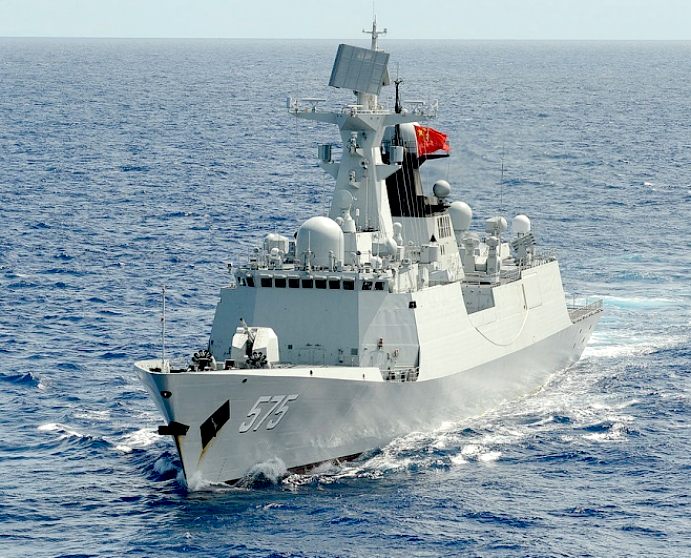
NAME
CHANGES
During the 19th century, the sea was known as the Mer de Corée (Sea of Korea) in French. It was one of the three main seas within East Asia, the other two being Mer du Japon
(Sea of Japan) to the north and Mer de Chine (Sea of China, today the
South China Sea) to the south.
Until World War
II, the sea was referred to as
東支那海
(Higashi Shina Kai; "East Shina Sea") in Japanese. In 2004, official documents of the Japanese Foreign Ministry and other departments switched to the name
東シナ海
(pronounced the same), which has become the standard usage in Japan.
The sea is called the East Sea in Chinese (東海; Donghai), being one of the Four Seas of Chinese literature. There are three other seas, one for each of the four cardinal directions.
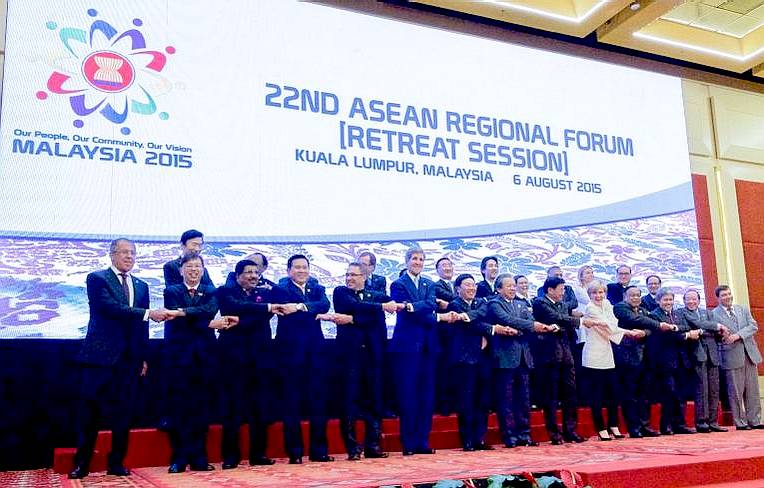
ECONOMY
The East China Sea is a very productive region. China, Japan, and North and South Korea actively fish in the area. Most of the
fishing is done by small local boats,
with some larger trawlers being used to catch: Tuna, mackerel, shrimps, sardines, milkfish, sea breams,
croakers. Shellfish and seaweeds are also harvested.
Petroleum and natural gas deposits have been discovered under the sea’s continental shelf.
As the world becomes more energy dependent, such discoveries have led to disputes between the bordering countries over control of areas with potentially exploitable hydrocarbon
reserves. Particular focus is on the regions around deep trenches, straits, rocks, and uninhabited islands. A small amount of China’s oil and
natural gas production comes from offshore wells in the East China Sea.
LINKS
& REFERENCE
Britannica
East China Sea Wikipedia
East_China_Sea
National
Interest unveiled new naval base the South China Sea http://www.ibtimes.co.uk/japan-china-islands-diaoyu-senkaku-taiwan-boats-387682 http://www.businessinsider.com/china-is-relentlessly-messing-with-japan-in-the-east-china-sea-2012-11?IR=T http://www.britannica.com/place/East-China-Sea https://en.wikipedia.org/wiki/East_China_Sea http://www.nationalinterest.org/blog/the-buzz/unveiled-chinas-new-naval-base-the-south-china-sea-12452 http://www.whatlauderdale.com/world-news/vietnam-opposes-temporary-chinese-ban-fishing-gulf-tonkin/15977/ http://www.britannica.com/place/Gulf-of-Tonkin https://en.wikipedia.org/wiki/Gulf_of_Tonkin http://english.vov.vn/Culture/Dang-Thu-Thao-crowned-Miss-Vietnam-Ocean-2014/276894.vov http://www.talkvietnam.com/2014/02/miss-vietnam-ocean-2014-kicks-off-in-april/ http://giadinh.net.vn/giai-tri/hoa-hau-viet-nam-2014-se-duoc-nhan-vuong-mien-tri-gia-25-ty-20141020141909032.htm http://www.hoahaudaiduongvietnam.com/ http://wordvietnam.com/your-say/tag/The%20Grand%20Beauty https://www.facebook.com/TheGrandHoTramStrip http://hanoitimes.com.vn/arts-entertainment/entertainment/2014/02/81E07681/miss-ocean-contest-hopes-to-increase-public-awareness/
http://vietnamnews.vn/life-style/255404/miss-ocean-winner-thao-makes-waves.html
http://wordvietnam.com/your-say/miss-ocean-vietnam-2014
http://news.yahoo.com/china-says-changing-position-sea-dispute-shame-ancestors-080310808.html http://www.nytimes.com/newsgraphics/2013/10/27/south-china-sea/ http://www.johnfeffer.com/is-chinas-rise-still-peaceful/
http://www.livemint.com/Politics/j2x5cxz1gxYQwDPmK5NtuN/India-Asean-to-dis
ACIDIFICATION
- ADRIATIC - ARCTIC
- ATLANTIC - BALTIC
- BAY BENGAL - BERING
- BLACK - CARIBBEAN - CORAL
- EAST CHINA SEA
ENGLISH
CH - GOC
- GULF GUINEA - GULF
MEXICO - INDIAN -
IOC
- IRC
- MEDITERRANEAN - NORTH
SEA - PACIFIC - PERSIAN
GULF
RED
SEA - SEA JAPAN - STH
CHINA - PLASTIC
- PLANKTON - PLASTIC
OCEANS - SEA
LEVEL RISE - UNCLOS
- UNEP
WOC
- WWF
AMAZON
- BURIGANGA - CITARUM - CONGO -
CUYAHOGA - GANGES - IRTYSH -
JORDAN - LENA - MANTANZA-RIACHUELO
MARILAO
- MEKONG - MISSISSIPPI - NIGER -
NILE - PARANA - PASIG - SARNO - THAMES
- YANGTZE - YAMUNA - YELLOW
|






